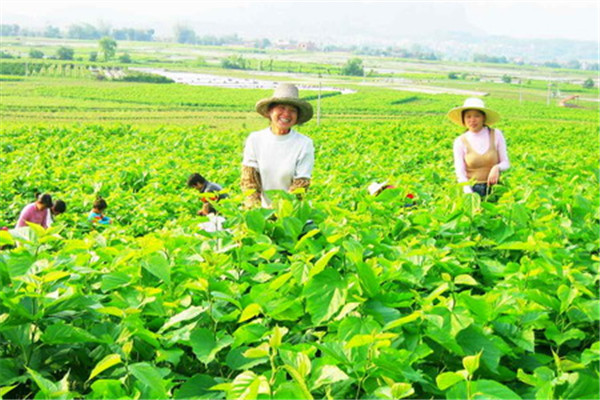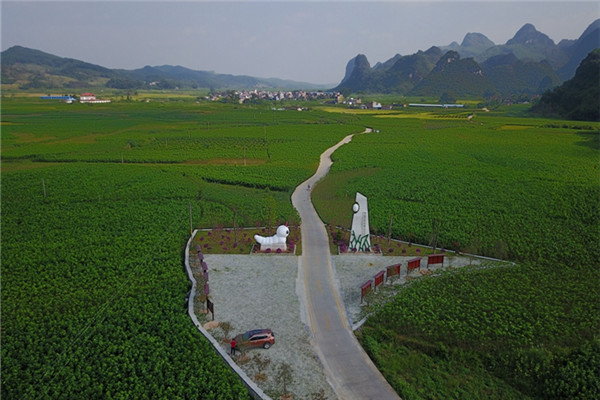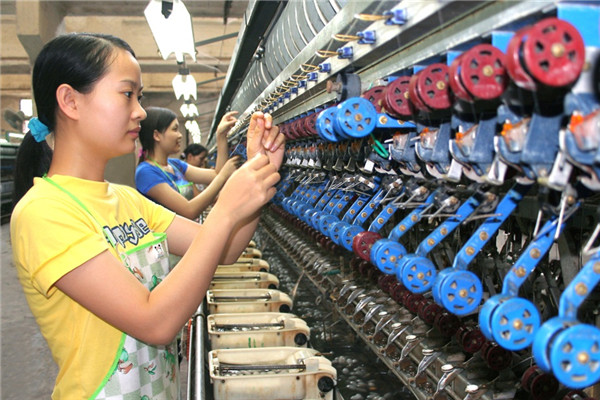Silkworms weave Yizhou's China Dream
By (chinadaily.com.cn)
2018-04-18
 |
|
Villagers work in the fields of a mulberry production base in Yizhou district. [Photo/gxny.gov.cn] |
Yizhou district in Hechi city, Guangxi Zhuang autonomous region is striving to develop a circular economy out of the mulberry, silkworm, cocoon, and silk industries, as well as auxiliary products.
In 2017, the district had 346,700 mu (23,113 hectares) of mulberry fields and 63,600 tons of raw cocoons, ranking first in the country on both measures for 12 consecutive years and bringing in as much as 2.754 billion yuan ($439.06 million). The district's 20 cocoon and silk processing enterprises produced 4,550 tons of white steam filature, 2.95 million meters of greige and 208,000 sets of silk quilts, for a total output of 6 billion yuan.
Yizhou has taken efforts to become a production base of high-quality raw cocoon and mulberry-related products and has developed several well-known brands, such as "Qiyuan" white steam filature, "Nanfang Sisao" and "Liusanjie" silk quilts.
An incubator for the cocoon silk industry was also established where enterprises can enjoy services in research and development, pilot scale production, business premises and office facilities.
 |
|
The "Liusanjie" mulberry industrial park extends to the foothills of Yizhou district. [Photo/gxny.gov.cn] |
Organizations, including 25 associations and cooperatives, were set up to promote technology which aids farmers in mulberry growing and silkworm breeding. The number of silk breeders in the district now exceeds 107,000, and their combined income is as much as 2.28 billion yuan, over 5,000 yuan per person.
The district has also made efforts to improve the value of mulberry and silk by developing innovative products such as mulberry tea, mulberry feedstuff, and mulberry fruits. There are 15 enterprises capable of making comprehensive use of mulberry and silk resources and seven enterprises capable of processing edible fungus from mulberry branches, producing a combined output value of 127 million yuan.
Yizhou has constructed an industrial park targeting the silk industry which has 229 sets of silk reeling machines and 40 sets of silk-weaving machines. More than 65 percent of locally produced raw cocoon can be processed at the park, boosting the value of the silk-processing industry to more than 1.6 billion yuan.
The ASEAN International Cocoon Silk Trading Center, with a cost of 1.5 billion yuan, has begun construction.
Importance was also attached to the application of advanced technologies. The district signed cooperation agreements with research institutions to develop better technology for silk-processing, mulberry-branch edible fungi and bio-safety disposal of silkworm excrement.
Experts were invited as counselors to provide guidance on developing sericulture. A doctoral workstation at Zhejiang University was set up to study silkworms and cocoon silk.
 |
|
Female workers are hard at work at a silk weaving workshop in Yizhou district, Hechi, Guangxi Zhuang autonomous region. [Photo provided to chinadaily.com.cn] |




